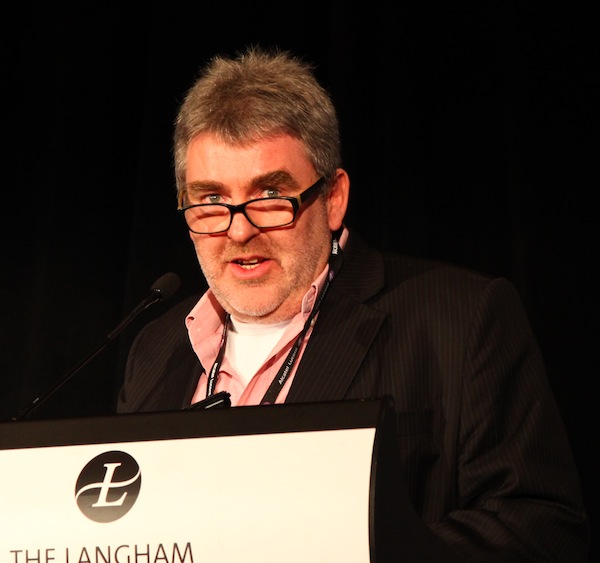Telstra must fix "dilapidated" copper for Libs' FttN NBN: iiNet

“Absolutely enormous” difficulties in getting Telstra to fix copper network faults confirm the value of fault-free fibre networks, iiNet’s chief technology officer has argued while outlining the company’s efforts to accommodate the new Coalition government’s FttN strategy and expected legislative changes.
Speaking to the recent CommsDay Melbourne Congress, iiNet CTO John Lindsay said that Telstra’s ongoing struggle to fix faults with its “dilapidated” copper network in a timely manner regularly posed challenges for ISPs seeking to build on that network – and that the VDSL2 technology at the core of Coalition’s strategy would require a mammoth commitment from Telstra to work effectively.

“It’s not so much that Telstra copper can’t actually be put into good order to provide VDSL2 service if there’s actually the demand to do that,” he told ZDNet Australia. “It’s more the challenge that wholesale customers of Telstra – and even, observably, retail customers of Telstra – have in getting copper faults fixed.”
“There are some portions of Telstra’s network that are really in a quite dilapidated state,” he continued. “The harsh reality is that there is quite a lot of very old, paper insulated, lead sheathed, gas filled cables that were installed in the 1950s and 1960s. Where that lead sheathing has deteriorated, the gas gets out and water gets in – and while paper is an awesome insulator when it’s dry, it’s a conductor when it’s wet.”
By contrast, customers connected to Labor’s fibre-to-the-premise (FttP) network were experiencing a “very, very low” fault rate that Lindsay said confirmed fibre was demonstrably superior to the existing copper. Yet with FttP on the wane as the Coalition’s policy kicked in, iiNet was re-emphasising its commitment to VDSL2 – and hoped that Telstra would do the same.
“That [old copper] part of the network poses a real problem,” he said. “The problems we face every day for customers connected by copper, and having those faults fixed, are absolutely enormous. An investment of effort to actually improve the quality of the copper could see a remarkable improvement in service – but at the end of the day it comes down to your willingness to maintain the infrastructure.”
iiNet under the Coalition
Lindsay’s comments were part of a wide-ranging speech in which he outlined the company’s successes so far under Labor’s FttP model – to which it has already connected some 20,000 customers – and its ongoing response to the election of the Coalition government, whose dependence on Telstra’s copper infrastructure had already caused a shift in some strategic investment.
In the wake of the Coalition’s election win, iiNet is running over 30 DSLAM builds to upgrade capacity at the most overloaded of its 440 exchange sites, where it had either run out or nearly run out of available ports to connect new customers.
“Our expectation was that the [Labor] NBN was going to be at quite large scale, and we were expecting to be decommissioning quite large sites by now,” Lindsay said, “but that’s not happening.”
“Our expectation was that the [Labor] NBN was going to be at quite large scale, and we were expecting to be decommissioning quite large sites by now, but that’s not happening.”
Even as it invests in new technology to support its copper-based business, Lindsay outlined some of the items on its wishlist for telecommunications policy under the Coalition government.
This included a hope that the party’s stated commitment to improve competition would result in the repealing of Labor-era ‘anti cherry picking’ laws that restrict new private-sector fibre rollouts to protect the fibre NBN from infrastructure competition.
“We are encouraged by the suggestion that there will be an attempt to increase infrastructure competition,” Lindsay said, “and we take that to mean that the anti cherry picking legislation that prevents us from extending our fibre networks more than 1km, for instance, should actually be removed.”
“However, based on our experience when the Rudd government was elected in 2007, I recall [former communications minister] Stephen Conroy saying that changing the direction of the department after the election was incredibly difficult. There is a mountain of things the new government wants to get through Parliament, and removing anti cherry picking legislation may not be at the top of that list.”
Other FttN-related issues on iiNet’s radar include the need for clarity around responsibility for greenfield fibre connections; whether FttN would look like wholesale ‘bitstream’ ADSL with “obligatory” PSTN; whether a FttN network would use the same points of interconnect (PoI) model as the established network; how voice services would be structured; whether NBN Co would be held to a customer service guarantee for all of its connections; and how NBN Co would revise its product set and pricing.